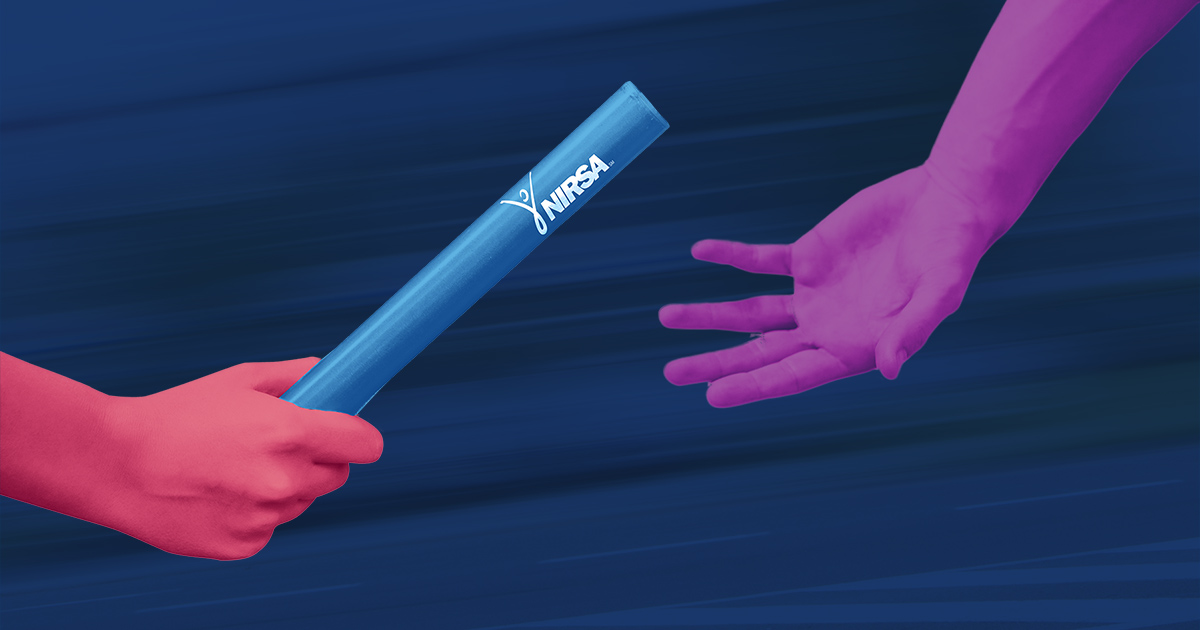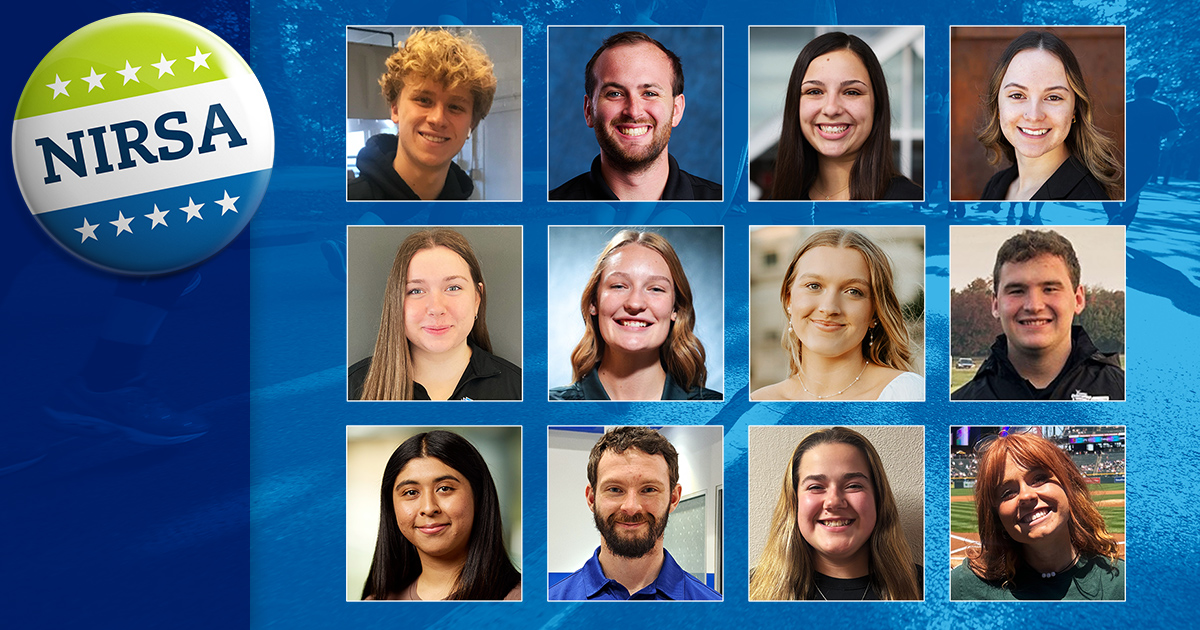By Erin O’Sullivan in collaboration with Frank Olive
“There is more to life than just classroom learning.” With these words, Frank Olive, Assistant Coordinator of Outdoor Adventures at the University of Alaska Fairbanks, echoes the inspiration and drive of so many NIRSA members.
College is a defining period in many people’s lives, and, often, it positively influences the habits of body and of mind that they follow long after.
Campus recreation departments across North America are striving daily to see that a part of their students’ future directions involves a commitment to wellness and healthy living.
Every rec department faces its own set of challenges when striving to inspire these essential values, but when your campus is in the middle of interior Alaska, and “real winter” brings snow and blistering cold from October through April, some might say you’re hands are pretty tied. Luckily, Frank, along with Mark Oldmixon, Director of UAF’s Department of Recreation, Adventure, and Wellness (DRAW), aren’t those people.
Alaska has some of the best skiing in the world. However, opportunities and excitement offered by the nearby mountain ranges are too far of a drive for most students to make consistent use of. A challenge for University of Alaska Fairbanks was creating chances for the students to do something “spicier than the regular gym activities they could pursue anywhere”—and doing it feasibly. So, Mark, Frank, and the DRAW team decided to revolutionize an old cliché; if they couldn’t (always) take the student to the mountains, they would bring the mountains to the students.
The result was two incredible outdoor campus rec opportunities: an ice climbing wall and a skiing/snowboarding terrain park—the first of its kind on college campuses. The wall, officially dubbed the UAF Outdoor Education Center, offers over 30 feet of challenge and adventure. “We saw one in town that a guy had made in his yard. It was great; so we thought, okay, how do we make it university-friendly?” Mark recalls.
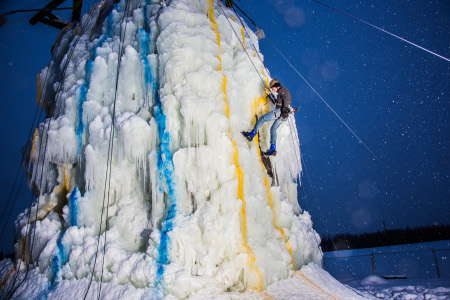
University of Alaska Fairbanks’ Outdoor Education Center.
This was followed, in December 2012, by the opening of the Hulbert Nanook Terrain Park. The park, which consists of three jumps, ranging from 25 to 40 feet, and a dozen rail elements, is located on a large hill just west of the climbing wall. All levels are welcome, though students must provide their own gear—excepting helmets, which are mandatory and available to rent.
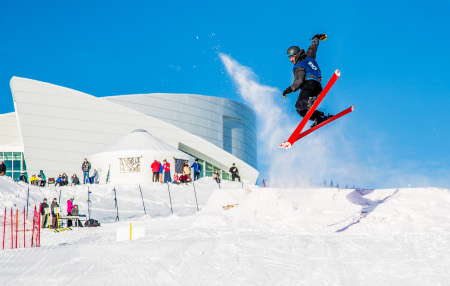
Hulbert Nanook Terrain Park at University of Alaska Fairbanks.
Given how successful the Outdoor Adventures program was with students, Frank and Mark knew the ice wall and the terrain park would be excitedly received—“we could show there was proof in the pudding,” Mark says. This helped in justifying their ideas, though, much to the UAF students’ benefit, , campus administration was also working towards the same vision as DRAW—bringing opportunities for outdoor recreation and natural wonder to the campus doorstep.
In making this happen, UAF held tight to four key principles:
- Be who you are, where you are
- Keep safety paramount
- Take care of the place that’s taking care of you
- Get active—make it happen
Be who you are, where you are
“At UAF,” Mark says, “we are Fairbanks.” And, in Fairbanks, the summers are glorious, the autumns brief, and the winters hard. But the students, 80% of whom are from the state of Alaska, know what they’re in for. And, one can rest assured that the other 20% from out of state and abroad haven’t arrived by accident. “I’ve never heard anyone bashing Fairbanks for being too cold when we’re out skiing, ice climbing, or watching the aurora dance over us,” Frank remarks.
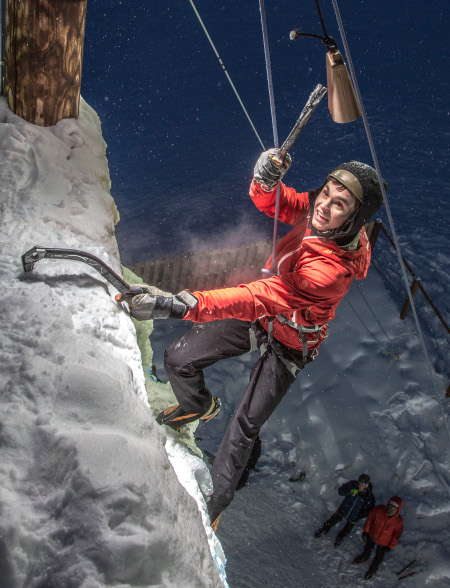
Outdoor recreation at University of Alaska Fairbanks.
Indeed, UAF’s most extreme challenges are, often in the same breath, its most extreme advantages. The Campus Master Plan encapsulates this, declaring a vision “to create a campus environment that reflects its unique natural and cultural setting, incorporating sustainability practices that are pertinent to UAF’s northern location.”
Keep safety paramount
After the initial idea, Mark made it clear that DRAW’s top priority was figuring out what it would take to complete these structures safely. They talked with colleagues in Risk Management and did their research. Then they called in the experts. While building the ice climbing wall, Mark says, they turned to the Association for Challenge Course Technology (ACCT), a “recognized organization with tried and true practices,” for guidance as they formed their standards.
When it came to building the terrain park, DRAW wanted to step up even further to distinguish itself from the barrels of snow and other homemade elements students have used in the past. So they looked to the US Terrain Park Council (USTPC) for “the physics of it,” in order to minimize injuries, and became the first campus in the United States to be USTPC certified.
Maintaining this safety-first mindset was just as essential as being true to their identity. Besides the obvious weather concerns—not operating if temperatures fall lower than -20 degrees—DRAW had to take into consideration how these new features would be staffed and administrated. For example, because the ice climbing tower involves a less-common skill set and experience level, the wall is staffed when open. This is unusual compared to their indoor wall, which only requires users to take a certification class to learn basic safety techniques before climbing on their own.
Other times, the safety measures focus more on the people around the users than the users themselves. For example, the terrain park is surrounded by a fence to keep activity from spilling onto the nearby cross-country ski paths that serve as a mode of campus transportation in winter months.
Staff members don’t overwhelm the area with their presence—the terrain park has seven student-staff and the climbing wall employs three to four—but they make up the right balance. The wall’s paid staff members are certified with basic skills, focusing mostly on running belays, while volunteers, allowed to climb on the clock whenever no other users are present, help out. Mark admits this makes them a “pretty skeletal operation compared to other facilities.” But, DRAW keeps a focus on quality over quantity—“we trust their decision making more than any technical skill set,” Mark says. And that focus is working.
Take care of the place that’s taking care of you
Where we are shapes who we are, and UAF is a prime example of that. From the breathtaking beauty of the mountains surrounding campus, to the unique courses—like Mountaineering—offered, to dry-living as an option for student housing, UAF is uniquely Fairbanks. Sustainability measures, then, aren’t just a tag line for DRAW. In Fairbanks, they can’t be.
“We don’t fight the weather,” Mark says. “We work with it.” Both features, then, are built to be utilized by students year-round. The climbing structure reserves its north facing wall for ice climbing and its south facing wall for rock climbing. The terrain park uses dirt mounds to create jumps, which stay in place as the snow melts away naturally. Once the grass is back, the rails and other elements get stored, and the open space becomes a disc golf course. Also, as it was built on an already open hillside, no trees needed to be cut down to construct it.
As heating buildings is by far one of the biggest expenses, and most resource-draining, aspects of life in Fairbanks, Mark and Frank elected to have a yurt serve as a staff station and student check-in center for each facility. The yurts’ pellet stoves were funded by the sustainability office, utilizing local wood that has been ground down, keeping it a renewable, community-based resource.
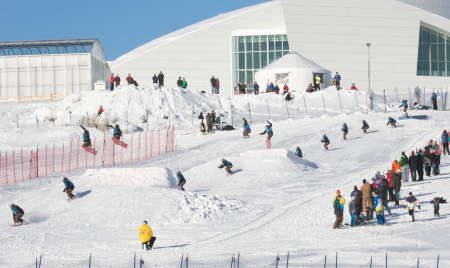
Hulbert Nanook Terrain Park at University of Alaska Fairbanks, with the yurt staff station pictured in the upper right-center.
The broader Fairbanks public was also an essential consideration—“at UAF, we’re deep rooted in the community,” Mark says. So not only did it go without saying that Fairbanks residents would be welcomed to use the ice wall and terrain park, but they were also an imperative first point of outreach for support.
Get active—make it happen
As UAF and Fairbanks are so closely tied, both features are largely funded by local donations: A Rotary dinner raised over $30,000, a generous sum, which was then furthered by a donor’s contribution of $180,000 over 6 years.
Mostly, though, these great new outdoor rec features exist at UAF because the DRAW team figured out how to turn ideas into reality. “Dream big. Don’t be afraid to ask for stuff,” Frank reflects. “When this first came up I thought it was a pipe dream.” Like any groundbreaking project, the terrain park would have happened without a dedicated visionary; the park was originally dreamt up by Erik Ofelt, DRAW’s Assistant Director of Facilities, and could not have been completed without his hard work and expertise.
“Dream big, but accurate,” Mark clarifies. “We used foundations that were there and turned to organizations with standards and scientific backing; we’re not making this up as we go.” Even so—even with the backing and support of both the chancellor and community—that didn’t mean everything came easy. “There were a lot of hoops to jump through,” Mark recalls, “and a lot of people to appease. Plus, as soon as we’d make progress the weather would change and we’d have to wait.” And, still, he says, perseverance pays off. “I’m a big believer in the old adage that the harder you work the luckier you get.”
NIRSA members know the lasting value of student engagement. Frank notes that “one of our long-term goals in promoting outdoor recreation is to create lifelong enthusiasts in the activities that we are passionate about, but a more immediate goal with is to keep students engaged and happy, helping them as they work towards their academic and personal goals.” So while students might think they’re just catching some air and trying out new tricks between classes, NIRSA recreation professionals, like Frank, Mark, and the DRAW team, know that, long after the snow melts, it’s these life lessons that will stick.




